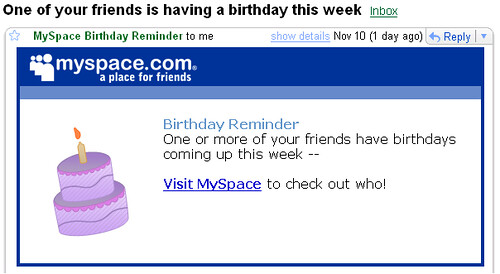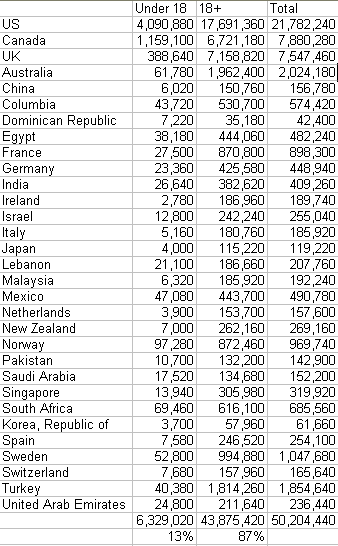Recently MySpace, the social networking site that once dominated but is now being overtaken by Facebook, sent me an e-mail informing me that a friend of mine had a birthday. What is unusual, is that although I have received notifications of this type when I had logged into the site, I had never been e-mailed.
Below is a copy of the e-mail, and lets see if you notice what I did:

It doesn’t tell me whose birthday it is. In fact, it is even ambiguous as to whether it was just the one person or not. Big deal? Not really. But it very clearly tells me something: MySpace is trying to increase its pageviews.
Social networking sites are very useful services to an individual; they enable a person to manage and monitor their personal networks. Not only am I in touch with so many people I lost contact with, but I am in the loop with their lives. I may not message them, but by passive observation, I know what everyone is up to. Things like what they’re studying, where they work, what countries they will be holidaying in, and useful things like when they have their birthday.
Social networking sites are not just a website, but an information service, to help you manage your life. However as useful as I find these services, the revenue model is largely dependent on advertising, with premium features a rare thing now. So when you rely on advertising, you are going to be looking at ways of boosting the key figures that determine that revenue stream.
Friendster’s surprising growth in May was due to some clever techniques of using e-mail, to drive pageviews. And it worked. E-mail notifications, when done tactfully, can drive a huge amount of activity. Of the what seems like hundreds of web services I have joined, e-mail at times is the only way for me to remember I even subscribed to it once upon a time. Combine e-mail with information I want to be updated with, and you’ve got a great recipe for using e-mail as a tool to drive page views.
…And that is the problem. MySpace has very cleverly sent this e-mail to get me to log into my account. A marketing campagn like that will at the very least, see a good day in pageview growth. But the reason I am logging in, is just so I can see whose birthday it is. Myspace now to me is irrelevant: those pageviews attributed to me are actually, not one of an engaged user.
Pageviews as a metric for measuring audience engagement is prone to manipulation. Increases in pageviews on the face of it, make a website appear more popular. But in reality, dig a little deeper and the correlation for what really matters (audience engagement) is not quite on par.
So everyone, repeat after me: Pageviews – we need to drop them as a concept if we are ever going to make progress.





